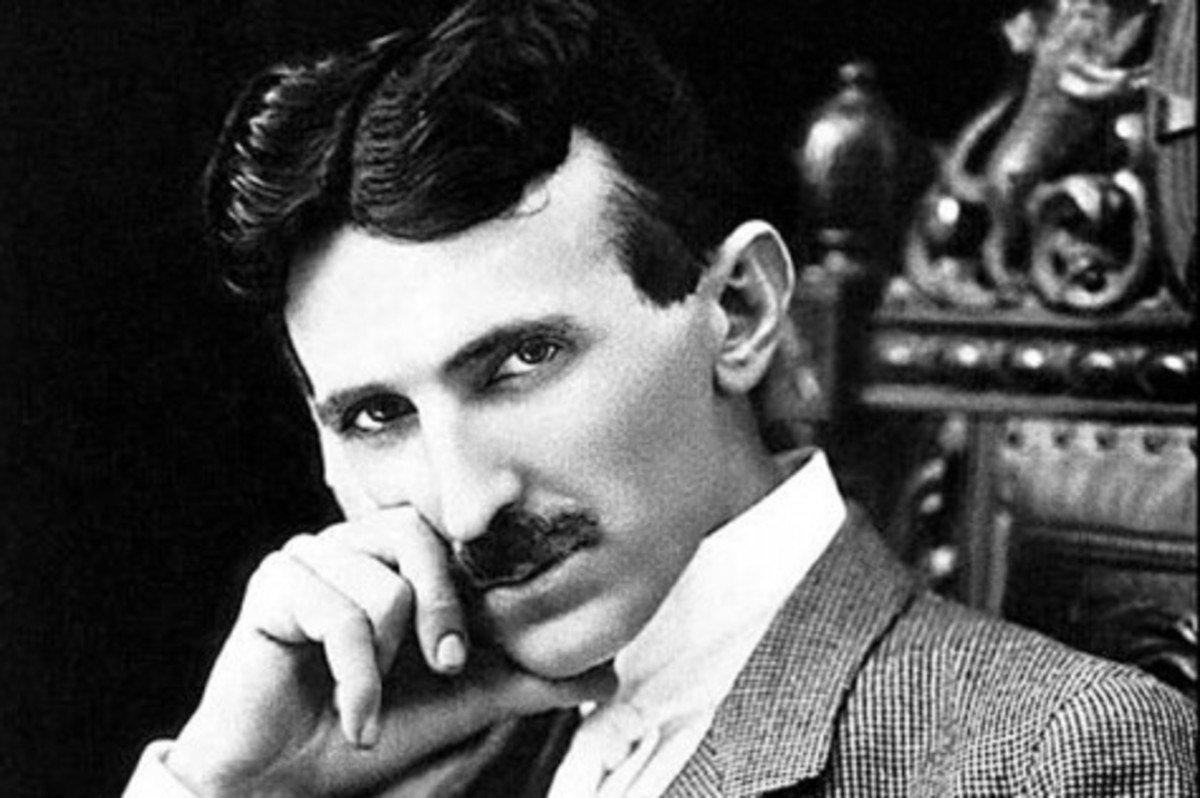- HubPages»
- Books, Literature, and Writing»
- Books & Novels»
- Nonfiction
Spiritual Autobiography

Introduction
Autobiographers write their life story for many reasons. One reason is purely selfish. Reflecting on one’s own life is therapeutic. Autobiography is cathartic because through writing a person can process what is going on his or her own mind.
In his article “Search for Meaning: Autobiography as a Spiritual Practice” John-Raphael Staude states that writing personal memoirs can help “[free] people from unresolved conflicts in the past and from outlived roles and self-imposed images…[and can bring] people an appreciation of their own inner wisdom” (Staude 250). Staude also thinks autobiography is “liberating” because it allows people to interpret events in a particular way and “to make peace with the past” (Staude 252).
Some people keep diaries or journals that are for their own personal use. They have no intention of sharing it. Others, though, write autobiographies for didactic purposes. As Staude says, “Autobiographers may write to teach, advise, convert or warn others, particularly the next generation” (Staude 254). One type of didactic autobiography is spiritual autobiography.
Staude defines a spiritual autobiography as “a history and interpretation of a person’s life written by the person who experienced it, considered in relation to its spiritual foundations” (Staude 250). Staude goes on to “define spirituality very broadly as the personal experience of connectedness and relationship to something transcendent, however that may be construed” (Staude 251). This connectedness could take the form of religion or it could manifest itself through “love, art, music, poetry, [or] nature” (Staude 251).
Because the intent of the spiritual self-narrative is to tell others about one’s religious or transcendent experience, the details in the autobiography pertain mainly to the person’s spiritual life. In her book Interpreting the Self, Diane Bjorklund says that “religious autobiographers [concentrate] on their transformations” (Bjorklund 62). In the preface to his autobiography, C.S. Lewis echoes the same sentiment. He says that once the general description of his early life or “the ‘build-up’ is complete, I confine myself strictly to business and omit everything (however important by ordinary biographical standards) which seems, at that stage, irrelevant” (Lewis viii).
The first spiritual autobiography is attributed to St. Augustine who published Confessions, a memoir pertaining mainly to his relationship with God. Since Confessions was published, spiritual autobiographies have followed essentially the same four-part pattern. Staude outlines these basic elements as:
(1) a description of the individual’s life before spiritual awakening; (2) an account of the events leading up to the individual’s encounter with God; (3) a description of the actual encounter with God and the impact of this event on the narrator; and (4) a celebration of the new life following this event. (Staude 258)
The way these four elements manifest themselves in three autobiographies, Surprised by Joy, Blue Like Jazz, and Everyday Matters, will be analyzed.
Trailer of Shadowlands movie based on the life of C.S. Lewis
C.S. Lewis and Surprised by Joy
C. S. Lewis, the well-known author of The Chronicles of Narnia and Christian apologetic books, wrote an autobiography of his conversion from atheism to Christianity. His book, titled Surprised by Joy: The Shape of My Early Life, follows the pattern laid forth by Staude.
Lewis begins by discussing his early life and relevant autobiographical information. He discusses what lead to his fall into atheism. His parents had taken him to church as a child, but he had never fully accepted Christianity. Once he went away to boarding school, he fell under the influence of professors and other students who introduced him to new philosophies which, “[l]ittle by little, unconsciously, unintentionally…loosened the whole framework, blunted all the sharp edges, of [his] belief” (60). He talks about his complete rejection of Christianity as a teenager by saying, “the impression I got was that religion in general, though utterly false, was a natural growth, a kind of endemic nonsense into which humanity tended to blunder (Lewis 63).
Lewis says that he did not realize it at the time that he was turning into “a prig; that is, an intellectual prig or (in the bad sense) a Highbrow” (Lewis 100). He started to become embittered and discontented because he had lost his communion with the spiritual part of himself when he stopped believing in the Divine. Nature, music, literature, and all of the old things that had given him joy no longer produced any pleasure. They became empty (Lewis 169).
Lewis then began studying and teaching at Oxford. This is when he started to encounter God in his life. His full conversion did not happen in one swift, dramatic moment. Rather, it was a gradual process that Lewis pictures as a chess game between God and himself. He met people who were Christians and began to debate with them about religion. He slowly slipped from atheism into a type of theism. God had him in check (Lewis 209). He started to reevaluate his entire outlook on life and the things that had caused him joy in the past. Lewis jests, “Really, a young Atheist cannot guard his faith too carefully” (Lewis 226).
All the evidence was pointing toward the truth of Christianity and Lewis realized that he, in fact, had come to accept that truth. He recounts the night that he had an actual encounter with God and his full conversion (the third element of the spiritual autobiography). Lewis writes, “I gave in, and admitted that God was God, and knelt and prayed: perhaps that night, the most dejected and reluctant convert in all England” (Lewis 228-9).
Lewis’ hesitation and aversion to Christianity began to fade after that night. He stopped being as self-absorbed. Lewis began attending church and learning more about Christianity (Lewis 233). Then the changes that his conversion caused in his life are celebrated in the autobiography (Staude’s fourth element). Though he regained a sense of joy in life, Lewis became unconcerned with the actual emotion. He recognized that the sensation of transcendent joy humans experience now and again is “valuable only as a pointer to something other and outer” (Lewis 238). Lewis realized that God is the true source of joy and earnestly began defending Christianity, a sharp contrast from his early point of view (Lewis 228-9, 238).
Trailer of Blue Like Jazz by Donald Miller
Donald Miller and Blue Like Jazz
The four common elements of spiritual autobiographies are also evident in Blue Like Jazz by the Christian writer and speaker Donald Miller. The book is a memoir of his spiritual journey. First, Miller discusses what he was like before he embraced Christianity. God was a slot-machine for him. Miller explains, “If something nice happened to me, I thought it was God, and if something nice didn’t, I went back to the slot machine, knelt down in prayer, and pulled the lever a few more times. I liked this God very much because you hardly had to talk to it and it never talked back” (Miller 9).
One particular episode stands out in his mind as indicative of the sort of person he was before his conversion. When he was thirteen years old, he had been given money to buy Christmas presents. He used most of it to buy something for himself, though, and bought his mother a horrible gift. He talks about how he felt overwhelmed with guilt because of his selfishness (Miller 9-11).
Miller also discusses the events that lead up to his conversion (the second element). He was at a protest rally petitioning against the World Bank when he had a revelation about the problems in the world. His epiphany was that “[t]he problem is not a certain type of legislation or even a certain politician; the problem is the same that it has always been. I am the problem” (Miller 20). He realized that the problems of the world cannot be fixed by Washington but by true change on the individual level.
Miller had another revelation one day as he and one of his friends, Tony, were discussing genocide and the other problems going on in the Congo. Tony asked him if he thought he was capable of committing that sort of evil. As they were talking about it, Miller realized that Tony was advocating the Christian outlook that man is a fallen creature. Miller writes, “ ‘Actually,’ I told him reluctantly, ‘I have always agreed with the idea that we have a sin nature…I do buy the idea that we are flawed, that there is something in us that is broken. I think it is easier to do bad things than good things’ ” (Miller 17).
The third element of spiritual autobiographies can be found in Blue Like Jazz also. Miller describes his encounter with God as containing all the parts of a literary story. He says, “And there it was: setting, conflict, climax, and resolution. As silly as it seemed, it met the requirements of the heart and it matched the facts of reality. It felt more than true, it felt meaningful. I was starting to believe I was a character in a greater story” (Miller 35). Once Christianity made sense to him on a personal level, he made a decision to follow Christ (Miller 34).
The impact of his conversion on Miller’s life is profound. The biggest change was that “God was no longer a slot machine but something of a Spirit that had the power to move men’s souls…The experience of becoming a Christian was delightful” (Miller 60). Staudes’ fourth element is present as Miller celebrates his new life by showing that the truths he had discovered “offered power over life, a sort of power that turned sorrow to joy, hardship to challenge, and trial to opportunity. Nothing in my life was mundane. After I became a Christian, every aspect of human interaction had a fascinating appeal” (Miller 59). After his conversion, Miller became active in the Christian community. Now he is a religious speaker and writes for Christian magazines (Miller 243).
Danny Gregory and Everyday Matters
Though it is not overtly religious, Everyday Matters by Danny Gregory is also a spiritual autobiography. The four elements outlined by Staude are present in the book, but instead of an encounter with God, Gregory has a transcendental experience of personal growth. He tells his life “before spiritual awakening” (Staude 258). He worked in advertising and his wife Patti was a stylist. Gregory describes their lives as “what we would have called a normal life in Greenwich Village in a nice apartment” (Gregory 3).
The catalyst event that lead to Gregory’s spiritual awakening was his wife’s accident. She fell in front of a subway train and became paralyzed. Gregory’s immediate reaction was anger and resentment. He writes:
If this was God’s idea of a lesson or a punishment for a former life’s transgressions, well, I wasn’t interested. There couldn’t be an explanation I could be bothered to accept. I was dazed and mad. What I needed to know was ‘what next?’ How do we remake our lives and be happy again? How do we get outta here?!! (Gregory 4)
Patti’s accident forced them to reevaluate their lives and discover what was truly important (Gregory 4-6).
The book describes other factors that lead Gregory to develop a new lease on life. His wife Patti became more courageous and determined, which was an inspiration to Gregory to make the best of their situation (Gregory 9). Another factor that impacted his spiritual growth was drawing. He started drawing the things around him and really studying what he was seeing (Gregory 12).
Staude defines spirituality “as the personal experience of connectedness and relationship to something transcendent” (Staude 251). He also says that it can manifest itself through art, which is exactly what triggered Gregory’s spiritual awakening (Staude 251; Gregory 13). Gregory describes the actual transcendent encounter experienced while drawing (Staude’s third element): “Something about that drawing was different from anything I’d done before. I took my time and then suddenly I zoned out. My mind went blank, my breathing slowed, and when I finally stopped to look at my page, I was amazed that I had managed to create anything so beautiful” (Gregory 13). Drawing, for Gregory, is like a form of meditation. It is his way to reflect on his life and to get in touch with his spiritual side. Gregory explains, “I try to feel [my] blessings, to become part of them and their source, whatever that is. And that communion, not these drawings, is the reason why I draw” (Gregory 23).
Drawing slowly began to impact his life for the better. Gregory stopped fretting about what he previously thought was a dire situation and began to realize that even though his wife is in a wheelchair now, she is still alive and able to function quite well (Gregory 93, 111, 6-7). He started appreciating the importance of everyday. Gregory realized that even the mundane things in life shape who a person is. The theme of the book is that “everyday matters” (Gregory 25) and that no one should take so-called trivial things in life for granted.
Finally, Gregory celebrates his new life by expressing gratitude for having such a wonderful person as Patti in his life. Seeing her strength helped him to experience a spiritual awakening in his own life. Gregory also rejoices about the new perspective on life that he has discovered through drawing. Gregory says that drawing “makes me better to myself, makes me reconsider a lot of things in my life, makes me take some risks and open some doors” (Gregory 75). He has come to appreciate that “What matters is today; all of the richness of my life seen as it really is” (Gregory 111).
Conclusion
Autobiographies of spiritual odysseys or growth as a human being are written to teach an essential idea or point the reader toward a goal. The authors have experienced something unusual that they feel compelled to share with the world. The audience is able to ascertain the same truth as the author by vicarious participation. In her article “Building a Bridge of Words” Jennifer Jensen Wallach expresses the vicarious nature of autobiography (Wallach 449). She says that autobiographies “give us a unique window into the interplay of thoughts and feelings, into how the universe felt from one particular point of view” (Wallach 448). As Stephen Spender emphasizes in his article “Confessions and Autobiography,” when a person writes an autobiography it “is transformed. It is no longer the writer’s own experience: it becomes everyone’s” (Spender 117).
C.S. Lewis, Donald Miller, and Danny Gregory all experience transformative spiritual encounters that they want to share with the world. The authors also want to persuade their readers to accept the same truths that they themselves have come to believe. That is the main factor that separates didactic autobiography from non-didactic. Spiritual autobiography is written in order to influence the lives of readers. The three autobiographies analyzed are powerful, poignant accounts of persons who have benefited from an encounter with the transcendent. Readers of spiritual autobiographies enhance their own life story by pondering the narratives of these authors.
Works Cited
Bjorklund, Diane. Interpreting the Self. Chicago: Univ. of Chicago Press, 1998.
Gregory, Danny. Everyday Matters. New York: Hyperion, 2003.
Lewis, C.S. Surprised by Joy. New York: Harcourt, Brace, and World, 1955.
Miller, Donald. Blue Like Jazz. Nashville: Thomas Nelson, 2003.
Spender, Stephen. “Confessions and Autobiography.” Autobiography: Essays Theoretical and Critical. Olney, James, ed. Princeton: Princeton Univ. Press, 1980. 115-22.
Staude, John-Raphael. “Search for Meaning: Autobiography as a Spiritual Practice.”
Wallach, Jennifer Jensen. “Building a Bridge of Words: The Literary Autobiography as Historical Source Material.” Biography 29.3 (Summer 2006): 446-61.















